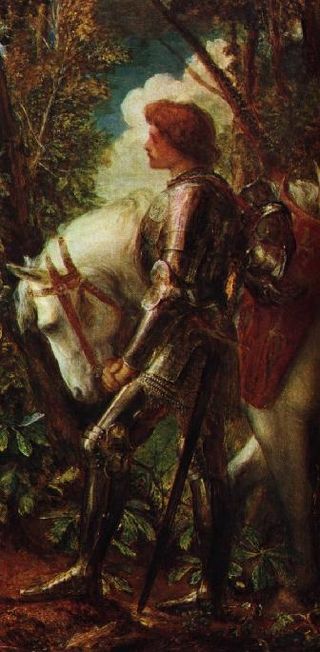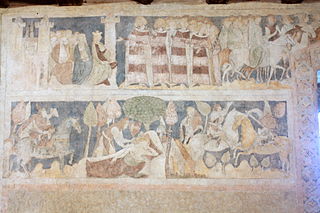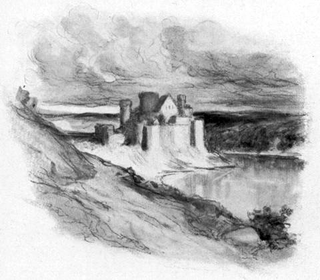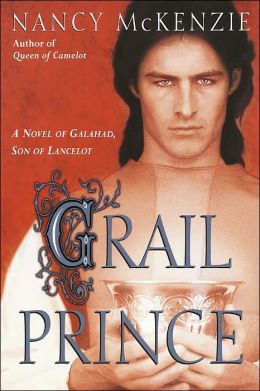
The Holy Grail is a treasure that serves as an important motif in Arthurian literature. Various traditions describe the Holy Grail as a cup, dish, or stone with miraculous healing powers, sometimes providing eternal youth or sustenance in infinite abundance, often guarded in the custody of the Fisher King and located in the hidden Grail castle. By analogy, any elusive object or goal of great significance may be perceived as a "holy grail" by those seeking such.

Lancelot du Lac, also written as Launcelot and other variants, is a character in some versions of Arthurian legend where he is typically depicted as King Arthur's close companion and one of the greatest Knights of the Round Table. In the French-inspired Arthurian chivalric romance tradition, Lancelot is an orphaned son of King Ban of the lost kingdom of Benoic, raised in a fairy realm by the Lady of the Lake. A hero of many battles, quests and tournaments, and famed as a nearly unrivalled swordsman and jouster, Lancelot becomes the lord of the castle Joyous Gard and personal champion of Arthur's wife, Queen Guinevere, despite suffering from frequent and sometimes prolonged fits of madness. But when his adulterous affair with Guinevere is discovered, it causes a civil war that, once exploited by Mordred, brings an end to Arthur's kingdom.

Galahad, sometimes referred to as Galeas or Galath, among other versions of his name, is a knight of King Arthur's Round Table and one of the three achievers of the Holy Grail in Arthurian legend. He is the illegitimate son of Sir Lancelot du Lac and Lady Elaine of Corbenic and is renowned for his gallantry and purity as the most perfect of all knights. Emerging quite late in the medieval Arthurian tradition, Sir Galahad first appears in the Lancelot–Grail cycle, and his story is taken up in later works, such as the Post-Vulgate Cycle, and Sir Thomas Malory's Le Morte d'Arthur. In Arthurian literature, he replaced Percival as the hero in the quest for the Holy Grail.

The Knights of the Round Table are the legendary knights of the fellowship of King Arthur that first appeared in the Matter of Britain literature in the mid-12th century. The Knights are an order dedicated to ensuring the peace of Arthur's kingdom following an early warring period, entrusted in later years to undergo a mystical quest for the Holy Grail. The Round Table at which they meet is a symbol of the equality of its members, who range from sovereign royals to minor nobles.

Percival, alternatively called Peredur, is a figure in the legend of King Arthur, often appearing as one of the Knights of the Round Table. First mentioned by the French author Chrétien de Troyes in the tale Perceval, the Story of the Grail, he is best known for being the original hero in the quest for the Grail, before being replaced in later literature by Galahad.
Percival's sister is a role of two similar but distinct characters in the Holy Grail stories within the Arthurian legend featuring the Grail hero Percival (Perceval). The first of them is named Dindrane, the second is usually unnamed and is known today as the Grail heroine.

The Fisher King is a figure in Arthurian legend, the last in a long line of British kings tasked with guarding the Holy Grail. The Fisher King is both the protector and physical embodiment of his lands, but a wound renders him impotent and his kingdom barren. Unable to walk or ride a horse, he is sometimes depicted as spending his time fishing while he awaits a "chosen one" who can heal him. Versions of the story vary widely, but the Fisher King is typically depicted as being wounded in the groin, legs, or thigh. The healing of these wounds always depends upon the completion of a hero-knight's task.

Bors is the name of two knights in Arthurian legend, an elder and a younger. The two first appear in the 13th-century Lancelot-Grail romance prose cycle. Bors the Elder is the King of Gaunnes (Gannes/Gaunes/Ganis) during the early period of King Arthur's reign, and is the brother of King Ban of Benoic and the father of Bors the Younger and Lionel. His son Bors the Younger later becomes one of the best Knights of the Round Table and participates in the achievement of the Holy Grail.

Conquests of Camelot: The Search for the Grail is a graphic adventure game released in 1990 by Sierra On-Line. It was the first game in the Conquests series designed by Christy Marx and her husband Peter Ledger. The only other game in the series was 1991's Conquests of the Longbow: The Legend of Robin Hood. Marx did the majority of the design work while Ledger created the game and package art.

The Lancelot-Grail Cycle, also known as the Vulgate Cycle or the Pseudo-Map Cycle, is an early 13th-century French Arthurian literary cycle consisting of interconnected prose episodes of chivalric romance originally written in Old French. The work of unknown authorship, presenting itself as a chronicle of actual events, retells the legend of King Arthur by focusing on the love affair between Lancelot and Guinevere, the religious quest for the Holy Grail, and the life of Merlin. The highly influential cycle expands on Robert de Boron's "Little Grail Cycle" and the works of Chrétien de Troyes, previously unrelated to each other, by supplementing them with additional details and side stories, as well as lengthy continuations, while tying the entire narrative together into a coherent single tale. Its alternate titles include Philippe Walter's 21st-century edition Le Livre du Graal.

The Post-Vulgate Cycle, also known as the Post-Vulgate Arthuriad, the Post-Vulgate Roman du Graal or the Pseudo-Robert de Boron Cycle, is one of the major Old French prose cycles of Arthurian literature from the early 13th century. It is considered essentially a rewriting of the earlier and more popular Vulgate Cycle, with much left out but also much added, including characters and scenes from the Prose Tristan. The cycle has not survived in any manuscript in its entirety and has been reconstructed from fragments in various languages.

Vengeance of Excalibur is a 1991 role-playing video game developed by Synergistic Software and distributed by Virgin Games. It is a sequel for Synergistic's 1990 title Spirit of Excalibur, set in Spain around the turn of the 10th and 11th Centuries. Vengeance of Excalibur puts the player in control of a small team of Knights of the Round Table who will seek out in Spain for the stolen items of the treasure of Camelot.
Sarras is a mystical island to which the Holy Grail is brought in the Arthurian legend. In the Lancelot-Grail Cycle, Joseph of Arimathea and his followers visit the island on their way to Britain; while there Joseph's son Josephus is invested as a bishop and shown the mysteries of the Grail by Christ himself. The party wins many converts, and moves on to Britain where they establish a great line of kings. After they achieve the Grail the knights Galahad, Percival, and Bors return the object to Sarras aboard Solomon's ship, but they find the residents fallen back to paganism. The Grail knights restore the people's faith and preside over them benevolently for a year, but Galahad dies in ecstasy when the Grail is taken to Heaven by God, and Percival follows him shortly after. Bors returns to Arthur's kingdom to tell the tale.

Corbenic is the name of the Grail castle, the edifice housing the Holy Grail in Arthurian legend. It is a magical domain of the Grail keeper, often known as the Fisher King. The castle's descriptions vary greatly in different sources, and it first appears by that name in the Lancelot-Grail cycle where it is also the birthplace of Galahad.

Adventures of Sir Galahad is the 41st serial released in 1949 by Columbia Pictures. Directed by Spencer Gordon Bennet, it stars George Reeves, Nelson Leigh, William Fawcett, Hugh Prosser, and Lois Hall. It was based on Arthurian legend, one of the very few serials of the time with a period setting that was not a western.

Grail Prince, a 2003 novel by American author Nancy McKenzie written in the tradition of Arthurian legends, recounts a version of Galahad's quest for the Holy Grail. The novel is a sequel to McKenzie's Queen of Camelot (2002).

King Arthur and His Knights of the Round Table is a retelling of the Arthurian legends, principally Thomas Malory's Le Morte d'Arthur, by Roger Lancelyn Green. It was intended for children. It was first published by Puffin Books in 1953 and has since been reprinted many times. In 2008, it was reissued in the Puffin Classics series with an introduction by David Almond, and the original illustrations by Lotte Reiniger.

"Sir Galahad" is a poem written by Alfred Tennyson, 1st Baron Tennyson, and published in his 1842 collection of poetry. It is one of his many poems that deal with the legend of King Arthur, and describes Galahad experiencing a vision of the Holy Grail. The subject of the poem was later included in "The Holy Grail" section of Tennyson's Idylls of the King, but the latter version depicts Galahad as a pious individual who is grimly determined to fulfill his destiny. Sir Galahad, in contrast, depicts Galahad as proud, and has almost cheerful undertones.

Hellawes the sorceress is a character in Thomas Malory's 15th-century Arthurian legend compilation Le Morte d'Arthur. She is lady of the Castle Nygurmous, associated with the chapel perilous episode in one of the quests of Lancelot.

















